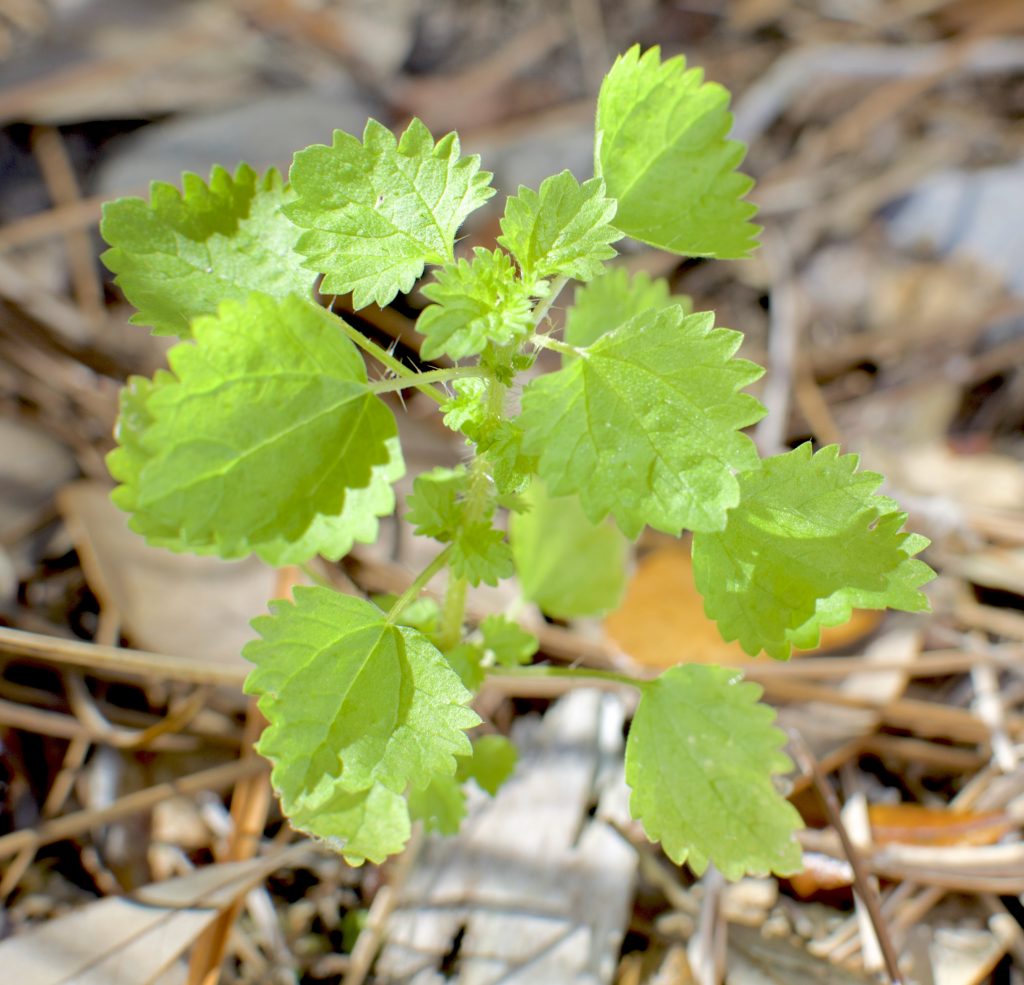
By April Stinging Nettles — genus Urtica — are usually gone for the season. They are cool-weather friends. But, Stinging Nettles are not down and out just yet. We saw several this past week in Largo, Florida. Large and seeding but they were still willing to sting badly anyone not well-clad or who handled them poorly. Called the Heartleaf Nettle the species earns its scientific name Urtica chamaedryoides which means “Stinging Dwarf.” It is perhaps the second-worst nettle sting on earth and not something you forget. They wound me badly but I can eat them with no problem. To learn more about the Heartleaf Nettle go here.For a video, here.
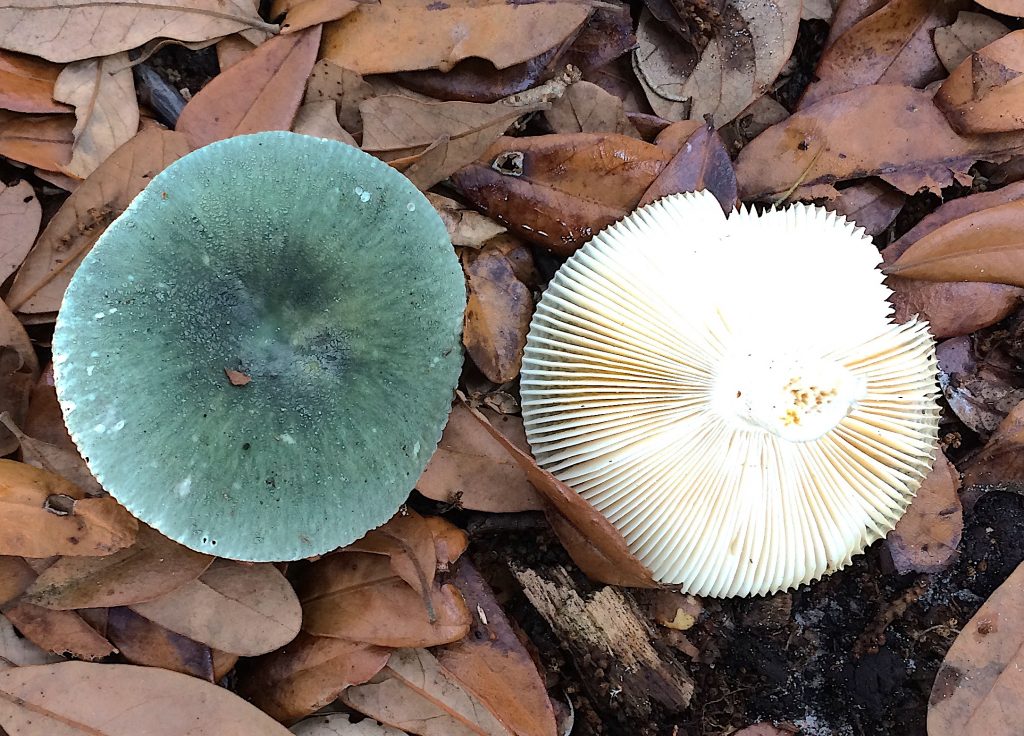
We are on the cusp of mushroom seasons or to be more specific we are in between mushrooms that like growing on wood in cooler weather, and, mushrooms that like growing in the ground and warmer weather. By an example, this past week growing in my lawn was the second Agaricus mushroom I have seen this year. I also harvested a few pounds of wood- growing Ringless Honey Mushrooms this week, usually a cooler weather species. A few more weeks of regular rain and warmer ground will move us into the summer session. Among mushrooms seen this past week was a green Russula. There are three quilt-work green Russulas in the Southeast and are all considered edible. There are also four or five non-patchy green Russulas edibility not specified but generally presumed so. The patchy ones are R. parvovirescens, R. crustosa and R. virescens though the latter might be misnamed in that R. virescens is now thought to be a European species only. Four non-patchy Russulas are R. subgraminicolor, R. aeruginea, R. variata and R. cyan-oxantha. The flavor of the patchwork ones is supposed to be nutty. No, I did not try this one. There are several problems associated with Russulas. One is basic identification. Next many Russulas are too spicy to eat. And they don’t have the best texture being rather crumbly. They are not, however, generally considered deadly just sickening. The green Russula above left is found consistently under a large oak with saw palmettos east of the YMCA building in Blanchard Park.
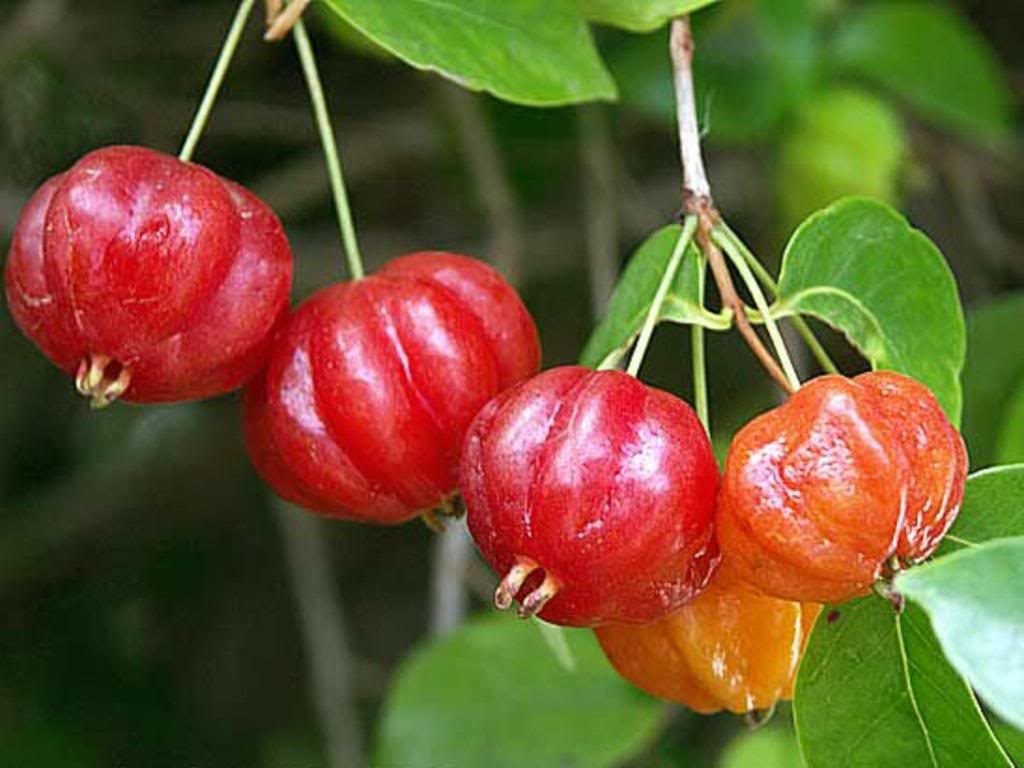
Last month we reported on ripening Surinam Cherries in south Florida. Of particular interest is that we saw the usual dark reds ones and the deep purple variety, generally sweeter and milder as well. I’m trying to get some of the latter to grow. This past week in Orlando — which is mid-state — we saw ripening Suriname Cherries, the red kind. They are best picked when deep red not orange red. Orange red is not ripe. Smaller than a ping-pong ball they resemble little red pumpkins with eight ribs. An imported fruit tree, it is naturalized throughout the state and rather easy to find. Generally you will either like them or hate them with few opinions in between To read more about the Suriname Cherry click here.
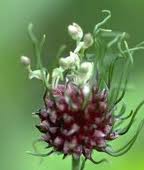
And while it is not the last gasp of Wild Garlic this is the mainstay of its season April. Look for it in damp but not inundated places. In Orlando that is drainage ditches along Narcossee Road. In Gainesville it’s a low field under a powerline or a ditch near Lake Noonan. In Ocala the shore of a drainage pond near Jervey Gantt Park. In Largo it is a long walk in Eagle Lake Park. The patch is removed from most other edibles on the north end in a hidden damp area. Fortunately a local student showed the patch to me a few years ago. It makes one wonder how long locals have been going to that spot for this comestible. Incidentally it stores well and no doubt first peoples used it extensively. You can read about Wild Garlic here.
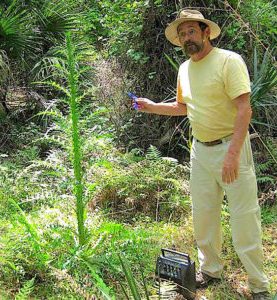
Foraging classes: The spring season is in full force and a wide number of edibles can be found at most locations. Only one class this weekend, in Sarasota. Sunday I am riding in a charity bike ride in Venice.
Saturday, April 27th, Red Bug Slough Beneva Road, Sarasota, FL, 34233. 9 a.m. to noon. Meet at the parking lot.
Saturday, May 4th, Colby-Alderman Park: 1099 Massachusetts Street, Cassadaga. Fla. 32706. 9 a.m. to noon. Meet by the bathrooms. This is a very nice small park that never attracts a large class but has a nice assortment of edibles.
Sunday, May 5th: Ft. Meade Outdoor Recreation Area, 1639 Frostproof Highway, Fort Meade, FL 33841. (Frostproof Highway is also Route 98.) 9 a.m to noon. Meet at the brown bathrooms in the middle of the park which is due south from the highway.
Saturday, May 11th, Dreher Park, 1200 Southern Blvd., West Palm Beach, 33405. 9 a.m to noon. Meet just north of the science center in the north section of the park.
Sunday, May 12th, Lake Woodruff National Wildlife Refuge, 2045 Mud Lake Road, DeLeon Springs, FL. 9 a.m. to noon. A few hundred feet after crossing the railroad tracks on Mudlake Road there in the parking lot on your right. We meet there. This is a hike of approximately four miles, two out and back mostly native species, very few ornamentals. While the walking is easy we are exposed to the elements, sun on a clear day, wind on a cold day. Check the weather, dress appropriately. Bring water, wear suitable footwear. Know that as it is federal land it can be closed anytime for any reason without notice.
Saturday, May 18th, Florida State College, south campus, 11901 Beach Blvd., Jacksonville, 32246. 9 a.m. to noon. We will meet at building “D” next to the administration parking lot.
Sunday, May 19th, Boulware Springs Park, 3420 SE 15th St., Gainesville, FL 32641. 9 a.m. to noon. Meet at the picnic tables next to the pump house.
Saturday, May 25th, Blanchard Park, 10501 Jay Blanchard Trail, Orlando, FL 32817. 9 a.m. to noon. Meet next to the tennis courts by the YMCA building.
Sunday, May 26th, Eagle Park Lake, 1800 Keene Road, Largo, FL 33771. 9 a.m. to noon. Meet at the pavilion near the dog park.
Saturday, June 1st, Bayshore Live Oak Park, Bayshore Drive. Port Charlotte. 9 a.m. to noon. Meet at the parking lot at the intersection of Bayshore Road and Ganyard Street. 9 a.m. to noon.
Sunday, June 2nd, Wickham Park: 2500 Parkway Drive, Melbourne, FL 32935-2335. 9 a.m. to noon.Meet at the “dog park” inside the park.
To learn more about the foraging classes or to sign up go here.
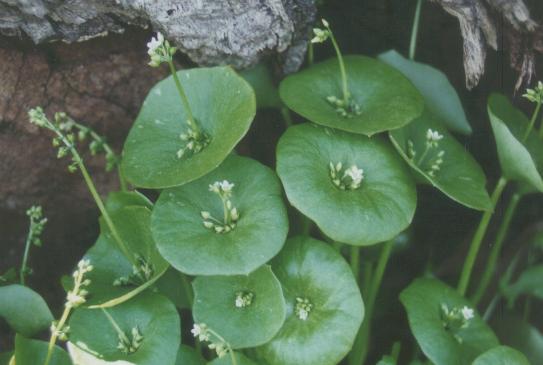
Across the country in parts of California Miner’ Lettuce is making its spring run and will be blooming through May. Dry, summer heat ends its season. This delectable comes from a family of other edibles — Claytonia — and was once lumped in with the purslane group. It doesn’t naturally get anywhere near Florida. The most distinctive feature of the Miner’s Lettuce is the leaf structure. Shaped like a saucer or cup the flower stalk pushes through the middle of the upper leaf. Difficult to mis-identify. It’s a resident of western North America with token populations in Georgia and northern New Hampshire. I have been unable to find any reference to it growing in Georgia in modern times. Miner’s Lettuce — which is high in vitamin C — is particularly common along the Pacific coast in shady spots and canyons. Its name comes from 1849 Gold Rush miners who ate it to stave off scurvy.
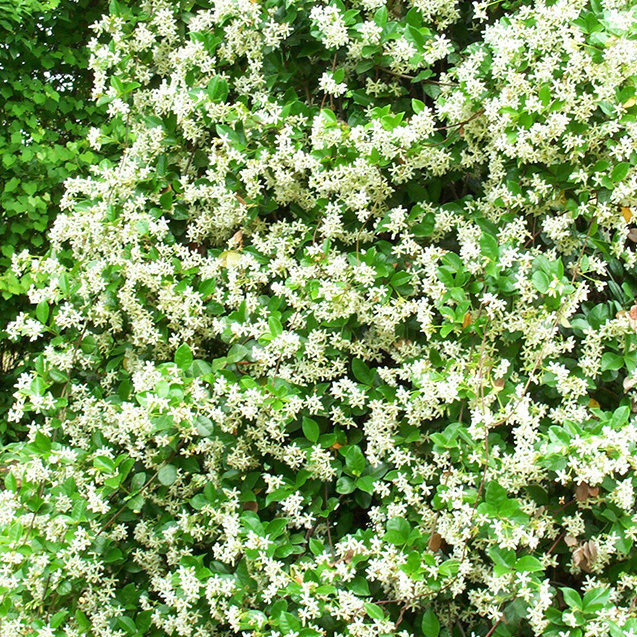
What is that oppressive aroma this time of year? It’s probably Confederate Jasmine. With a scent similar to White Shoulders perfume and perhaps Gardenias, it’s a month-long cause of headaches for this writer. I’m not alone in that assessment. Enough of us disliked it that on a recent bike ride we could have formed a Political Action Committee again it. While some call the fragrance “intoxicating” many of us call it nauseating. Worst, despite its name the species is native to China and is not a true Jasmine. Also called Star Jasmine and known scientifically as Trachelospermum jasminoides, the tough vine is pest-free, a vigorous grower and drought resistant. That is why you see…. ah… smell it everywhere. It can even be made into a small hedge. Its sap is sticky and can stain me, thee and our tools and clothes. Decades ago in a desperate attempt to make something useful out of this invasive species I tried making wine out of the blossom. The wine was toxic. Too bad. It tasted like bacon.
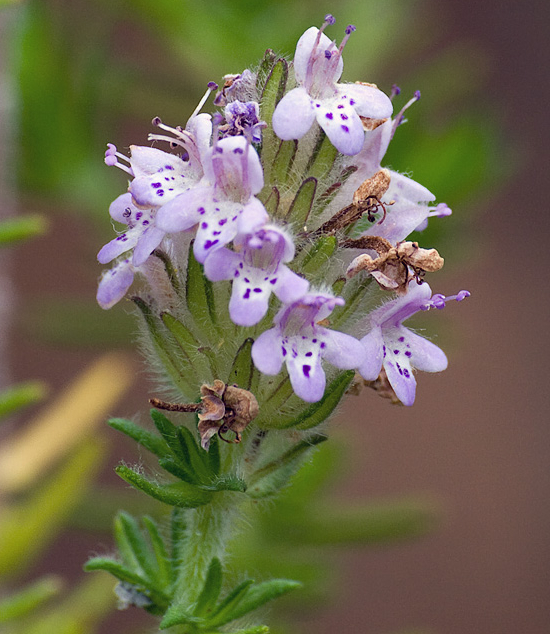
Some plants are in your face… or nose. One sees them everywhere and they announce themselves with color, shear numbers or aroma. Kudzu is a prime example of the latter. When in bloom you can’t ignore its intense grape fragrance. Other plants are more shy. They are no less important, no less impressive in their own way but reserved, wall flowers that could have been a bouquet. Florida pennyroyal is just such a scrub land denizen. It used to be the third most common source of nectar for bees in the state. It fell off the list completely in recent decades. No one quite knows why. Florida Pennyroyal has been blossoming for a while. And as pretty as they are it is only when you crush a leaf do you get an almost startling waft of pennyroyal. This little species is so select it is also a monotypic genus, meaning it has no close relatives and no one else to share the genus with. To read more about the Florida Pennyroyal go here.
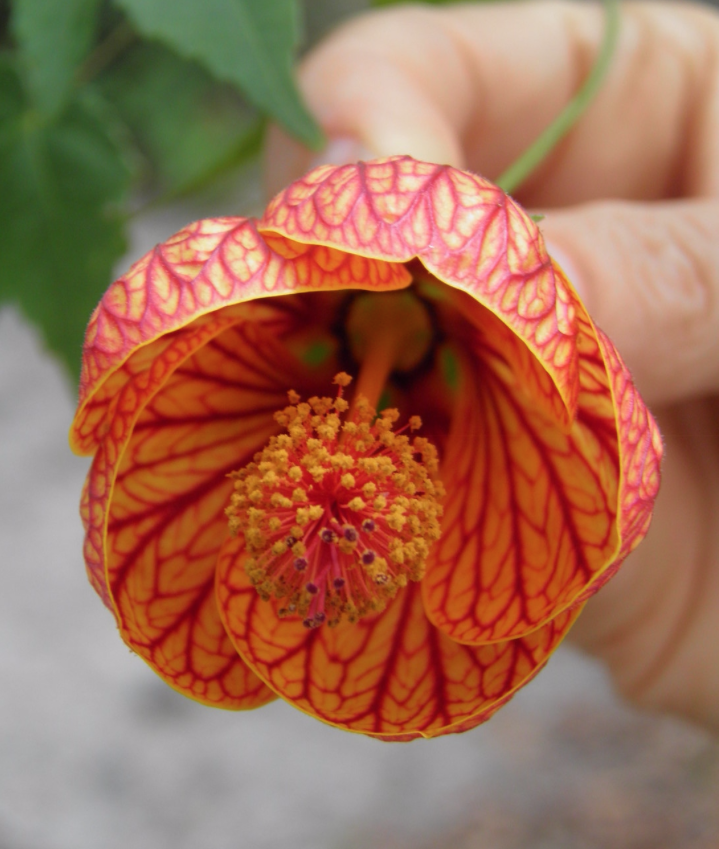
One of the benefits or banes of foraging in a warm climate is there are a lot of exotic plants, often edible or medicinal. That requires a lot of research and head scratching done by better minds than mine. It is not unusual to find five or six new species a year to add to the long list. While I am certain there are a few thousand different edible species here — if one counts all the relatives — I suspect there are really several thousand. No one finds more of them than Andy Firk in Arcadia. One of his colorful discoveries is the Redvein Abutilon, Abutilon pictum (syn. A. striatum) of the Mallow family. Andy says it’s native to Brazil, Argentina, Paraguay and Uraguay. The good news is that the flowers are edible raw or cooked, and they get sweeter the more open they become. You can find Andy on Facebook.

All My Videos are available for free on You Tube. They do have ads on them so every time you watch a Green Deane video I get a quarter of one cent. Four views, one cent. Not exactly a large money-maker but it helps pays for this newsletter. If you want to see the videos without ads and some in slightly better quality you can order the DVD set. It is nine DVDs with 15 videos on each for a total of 135 videos. Many people want their own copy of the videos or they have a slow service and its easier to order then to watch them on-line. The DVDs make a good gift for that forager you know especially as spring is … springing. Individual DVDs can also be ordered or you can pick and choose. You can order them by clicking on the button on the top right hand side of this page (if your window is open wide enough.) Or you can go here.

Donations to upgrade EatTheWeeds.com have gone well. Thank you to all who have contributed to either via the Go Fund Me link, the PayPal donation link or by writing to Green Deane POB 941793 Maitland FL, 32794.

Want to identify a plant? Looking for a foraging reference? Do you have a UFO, an Unidentified Flowering Object you want identified? On the Green Deane Forum we chat about foraging all year. And it’s not just about warm-weather plants or just North American flora. Many nations around the world share common weeds so there’s a lot to talk about. There’s also more than weeds. The reference section has information for foraging around the world. There are also articles on food preservation, and forgotten skills from making bows to fermenting food. One special section is “From the Frightening Mail Bag” where we learn from people who eat first then ask questions later. You can join the forum by clicking on “forum” in the menu.
This is weekly issue 352.


Miner’s lettuce here in the Bay Area, California is mostly done already. I would say 75% of them are losing color and forming seeds. But it was a great run this year from late January until now!
Deane,
What? No mention in your newsletter about poke salet? It’s in all its glory here in Tennessee at the present time. Can’t miss the yearly ritual of indulging in this culinary delight.